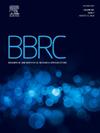Two medicinal molecules Hydralazine and Isoniazid have the potential to control wheat crown rot by combing with a N-acetyltransferase FDB2
IF 2.5
3区 生物学
Q3 BIOCHEMISTRY & MOLECULAR BIOLOGY
Biochemical and biophysical research communications
Pub Date : 2024-10-24
DOI:10.1016/j.bbrc.2024.150893
引用次数: 0
Abstract
Fusarium pseudograminearum is the main pathogen that causes wheat crown rot (WCR), causing serious harm to wheat production. Wheat secretes Benzoxazolinones (Bxs) as fungicidins to prevent F. pseudograminearum infection. Fusarium Detoxification of Bx 2 (FDB2) can degrade Bx to non-fungitoxic N-(2-hydroxyphenyl) malonamic acid. Therefore, FDB2 may be a potential drug target for WCR.
In the present study, the structure of FDB2 was determined using the molecular replacement method. The overall FDB2 structure displayed a typical N-acetyltransferase (NAT1) conformation. Unlike other NAT1s, the active site cleft is divided into two parts by a long loop (A135MSPYPDVRKNQA147). Hydralazine, Isoniazid, and 2,4′-dibromoacetanilide were screened out as potential inhibitors of FDB2 by structure alignment. Affinity measurements by MST showed that FDB2 prefers to combine Isoniazid and Hydralazine rather than its natural substrate, 2-aminophenol. Wheat seedling infection assays showed that Isoniazid and Hydralazine suppress F. pseudograminearum invasion in wheat. Our study found that Hydralazine and Isoniazid have the potential to control WCR. This article provides a new idea for the application of medicine, which has serious adverse effects, on plant disease control to reduce research costs and make obsolete drugs shine with vitality.
通过与 N-乙酰转移酶 FDB2 结合,两种药物分子 Hydralazine 和 Isoniazid 有可能控制小麦冠腐病。
假根镰刀菌(Fusarium pseudograminearum)是引起小麦冠腐病(WCR)的主要病原体,对小麦生产造成严重危害。小麦分泌苯并噁唑啉酮(Bxs)作为杀菌素来防止假镰刀菌感染。Fusarium Detoxification of Bx 2(FDB2)能将 Bx 降解为无真菌毒性的 N-(2-羟基苯基)丙二酸。因此,FDB2 可能是治疗 WCR 的潜在药物靶点。本研究采用分子置换法测定了 FDB2 的结构。FDB2 的整体结构显示出典型的 N-乙酰转移酶(NAT1)构象。与其他 NAT1 不同的是,活性位点裂隙被一个长环(A135MSPYPDVRKNQA147)分为两部分。通过结构比对,筛选出肼屈嗪、异烟肼和 2,4'-二溴乙酰苯胺作为 FDB2 的潜在抑制剂。通过 MST 进行的亲和力测量表明,FDB2 更喜欢结合异烟肼和肼屈嗪,而不是其天然底物 2-氨基苯酚。小麦幼苗感染试验表明,异烟肼和海德拉嗪可抑制假丝酵母菌对小麦的侵染。我们的研究发现,Hydralazine 和异烟肼具有控制 WCR 的潜力。本文为将具有严重不良影响的药物应用于植物病害防治提供了新思路,降低了研究成本,使过时的药物焕发出勃勃生机。
本文章由计算机程序翻译,如有差异,请以英文原文为准。
求助全文
约1分钟内获得全文
求助全文
来源期刊
CiteScore
6.10
自引率
0.00%
发文量
1400
审稿时长
14 days
期刊介绍:
Biochemical and Biophysical Research Communications is the premier international journal devoted to the very rapid dissemination of timely and significant experimental results in diverse fields of biological research. The development of the "Breakthroughs and Views" section brings the minireview format to the journal, and issues often contain collections of special interest manuscripts. BBRC is published weekly (52 issues/year).Research Areas now include: Biochemistry; biophysics; cell biology; developmental biology; immunology
; molecular biology; neurobiology; plant biology and proteomics

 求助内容:
求助内容: 应助结果提醒方式:
应助结果提醒方式:


